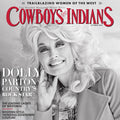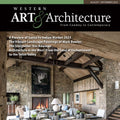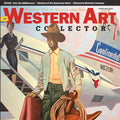Western Bonds: Artists and Nature
By Medicine Man Gallery on
Western Bonds
Exploring the relationship of artist to nature expressed through art.
By John O'Hern
Published online courtesy Western Art Collector, March, 2010
Thoreau traveled from Concord to Quebec but he never made it to the West. Nevertheless, his experience and lessons of man's relationship to nature are true no matter where you are. "Every creature is better alive than dead, men and moose and pine trees," he wrote, "and he who understands it aright will rather preserve its life than destroy it."
A Blackfeet camp of two tepees is set up on the shore in Nicholas Coleman's painting The Great Spirit. The compositional elements are left of the center, from soaring birds to encampment to reflection of the tepees in the still water. Even the horses face away from the vastness of the prairie. Nick describes this as "a rather subdued painting with more atmospheric tones." Silhouetted against the white tepee, a figure raises his hands while telling his companion the story of Apistotoki, "The Great Spirit." The lack of dramatic skies or landscape behind the encampment draws the viewer's attention to the camp and to the gesturing figure. "I want the viewer to imagine him or herself being there, listening to the story, smelling the smoke of the fire, and bringing their own experiences to the painting," says Coleman.
Jane Shea refers to a spirituality of a different sort in her tiny egg tempera painting of San Antonito Church. The small mission church was built around 1866 as "an archetypical Spanish Colonial village church." The tumultuous arrival of the Spanish into the area and the subsequent battles with the native peoples is only a memory at this bucolic site. The church once housed a processional cross that was saved from a church destroyed in a revolt in 1715 elsewhere in northern New Mexico. Shea's characteristic application of the ancient medium of egg tempera lends softness to the building and to the grasses of the cemetery. The theme of blues and greens surrounding the shadowed curves of the church create an image of calm strength.
Bill Owen has been called "The Cowboy's Artist." His mother was an artist and his father was a cowboy. His goal is "to record what he believes to be the true endangered species of our time: the contemporary working cowboy." The relationship of the cowboy to his horse and to nature is intimate. A "starving cowboy" stands on the saddle of his emaciated mount, reaching for the edible fruit of a saguaro cactus in Owen's moving sculpture. This cowboy also knows that he can find water in his desert environment by searching out the barrel cactus.
Suzanne Baker paints the relationship between man and animal in the West. Paint Portrait is a clever pun on her subject of cowboys on their horses herding cattle - and the errant calf. One cattleman rides a paint horse, a spotted horse bred for its muscularity and maneuverability - necessary characteristics for its demanding job. Her energetic application of paint is ideal for her renditions of cowboy life. She was brought up in an area of large ranches and saved her money to buy a horse when she was 11. She rode bareback for three years until she could afford to buy a saddle. Her physical awareness of her subjects and her skill with paint allow her to paint portraits of the people and animals that teem with life.
When tourists began to visit the Southwest, the native people began producing pottery especially for this new market, not only for their own daily use. Dennis Ziemienski's Runningboard Sale depicts Indian potters sitting on the running board of a car owned by the Fred Harvey Company, which pioneered services for vacationers in the West. Ziemienski's colors are those of the Southwest and his bold compositions have been influenced by travel poster art of the early 20th century. The scene is similar today, especially in Santa Fe, where Indian artists display their wares under the long portal of the 17th-century Palace of the Governors facing the Plaza.
Nicholas Coleman's father, Michael Coleman, gets closer to a primordial source of creativity and energy with his view of Old Faithful. No fences, no tourists, no cars. A black bear and some birds encounter the geyser and, perhaps, gaze with the same astonishment the explorers expressed when they came upon the site for the first time in 1870. The spectacular effect of the spouting water and steam is the central theme of the painting but the geyser's effect on the environment is also apparent. An ephemeral rainbow appears in the mist to the right, and the foreground, which gives weight to the painting, is colored by the dissolved minerals that have erupted in the plume and have been deposited on the ground.
The naturalist John Muir knew the delicate balance among all things in nature. He wrote, "When one tugs at a single thing in nature, he finds it attached to the rest of the world."
Santa Fe Editor John O'Hern, who has retired after 30 years in the museum business, specifically as the Executive Director and Curator of the Arnot Art Museum, Elmira, N.Y., is the originator of the internationally acclaimed Re-presenting Representation exhibitions, which promote realism in its many guises. John was chair of the Artists Panel of the New York State Council on the Arts. He writes for gallery publications around the world, including regular monthly features on Art Market Insights in American Art Collector magazine. Having succumbed to the lure of the West, he now lives in what he refers to as a "converted adobe goat shed," in the high desert of New Mexico, where he is acquainting himself with new flora and fauna.



